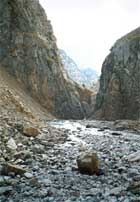

History of Gorno-Badakhshan |
 Persian Empire
Persian EmpireFrom about 500 BC, most of Central Asia was under Persian control or influence. Bactria (today thought to be Balkh in Northern Afghanistan) on the banks of the Oxus (now known as the Amu Darya) was the center of Persian civilization in Eastern Iran. The Persians displaced the Scythian and Cimmerian nomadic tribes in the region. Afrosiab (now Samarcand) was the centre of the region known as Sogdiana that covered what is today Southern Uzbekistan and much of Tajikistan. The cities of Samarcand and Boukhara, although today in the territory of Uzbekistan, are centres of Tajik/Persian culture. Alexander
the Great The Persian Sasanids (224-642 AD) destroyed the Kushan Empire and the region reverted to Persian control. |
Copyright © 2004-2012 PAMIR TRAVEL
Made by: MabigaTeam